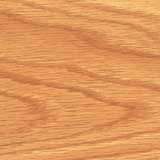|
Oak can truly be called the Sovereign Wood of America. There are about 500 species of Oak recognized in the world, with about 60 species common to the United States. It is cut commercially in about 40 states.
Most Oak lumber production is confined to regions east of the Great Plains, with the greatest production being reached in the Deep South, including Tennessee. Most of the Oak is marketed under White Oak or Red Oak, in about equal amounts. The other two important species are Live Oak and California Tanbark Oak. White Oak is the ranking group and as sold commercially usually includes: White Oak, Bur Oak, Chinquapin Oak, Overcup Oak, Post Oak, Swamp Chestnut Oak and Swamp Oak. These Oaks are sometimes known by different common names in different localities, such as Rock Oak, Yellow Oak, Yellow Chestnut Oak, Basket Oak and Cow Oak. White Oak is one of the best all-purpose and most used of all American woods. Many different types of grain and figure are obtained from the log by varying the angle of sawing for lumber or slicing for veneer. In the form of lumber quartered, White Oak was formerly very popular for decorative purposes because of the pleasing figure obtained by sawing the log at an angle. This brings out and emphasizes the radial grain in broad flakes crossing the ring growth from the center of the tree. The comb grain effect that is more popular today is obtained by sawing or slicing the log at an angle which emphasizes the ring growth with scarcely any visible radial grain. In the form of veneer, White Oak is usually rotary-cut, sliced or sawn. The rotary-cut veneer has quite a pronounced grain figure while sliced or sawn veneer can be flat grain, quarter-sawn, rift-sawn or comb grain. The veneer log is also sometimes cut on the half-round or with a staylog to produce novelty grain effects. The ends of the medullar rays are usually longer in White Oak than in Red Oak on plain-sawn or sliced surfaces. The natural color of White Oak ranges from a light brown with a grayish tinge of the heartwood to lighter tones of ochre or near white of its sapwood. Quartered White Oak shows a very prominent flake in silver grain or elusive flakes created by the large medullar rays which reflect light. The wood has good color, a naturally attractive figure and a fine texture for a coarse-grained wood, together with a natural resilience and warmth. White Oak is characterized by abundance, hardness, strength and good appearance. Its all-purpose adaptability to various types of finishes makes it qualify for all types of wood construction. Its texture ranges from medium to firm and the heartwood pores are so obstructed at intervals with styluses that the wood is virtually waterproof. White Oak is outstanding for steam bending, as used in manufacture of chair parts, aircraft and marine construction. It is known for its toughness, elasticity, and resistance to decay, and nail and screw holding properties. It is a favorite wood for floors, interior trim and paneling. Because of its durability in contact with the soil, it is also popular for use as railroad ties and structural material, mining props and fencing material, posts and poles. Ranking among the leading cabinet woods of this country, White Oak is one of the woods most commonly used in furniture, both in the form of lumber and as a veneer. At the present time it is widely used for modern furniture which requires natural or the popular blonde finishes. White Oak is much used in the manufacture of vehicle parts and agricultural implements, such as plow beams, brake beams, corn grinders and binders, doubletrees, drags, felloes, gear woods, frames, hay rakes and balers, hubs, plow parts, spokes, and windmill parts. In the utility field, it is also popular for casings, cages, ladders, wire reels, sandboards, switchboards, tool chests, tanks and vats. In the specialty field, it is the leading wood for church furniture and fixtures, store fixtures, office equipment, caskets, barber furniture, bar fixtures, billiard and pool tables, handles, brush blocks, refrigerators, sewing machines, doors, cabinet work, mill work and all kinds of planning mill products. White Oak also is used in the manufacture of basket parts, butter churns, piano parts, sleds and wagons, and truck body and trailer parts. |

